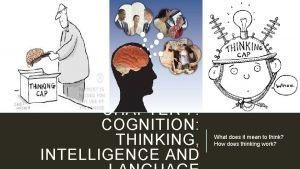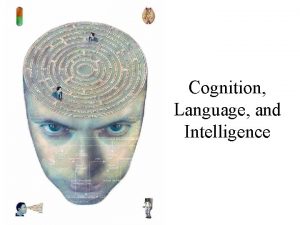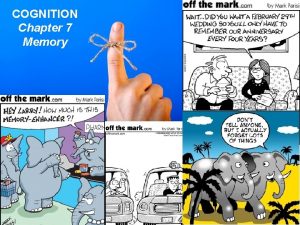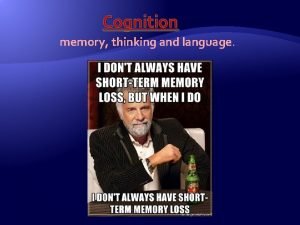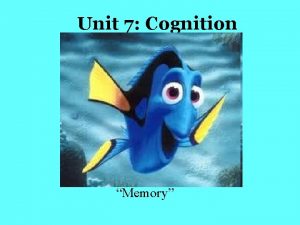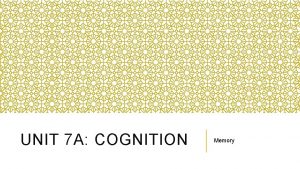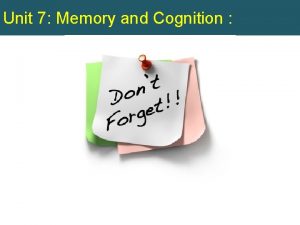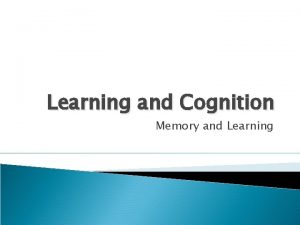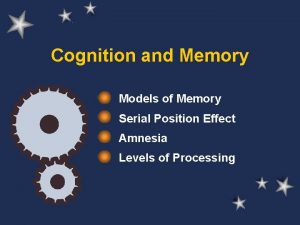Cognition Chapter 7 Memory Cognition The way in















- Slides: 15

Cognition: Chapter 7 Memory

Cognition • The way in which information is processed and manipulated in remembering, thinking, and knowing. • Includes: Memory, Thinking, and Language

Processes in Memory Three step process… 1. Encoding: processing information into the memory 2. Storage: retaining memories over time 3. Retrieval: getting information out of memory

Biology of Memory • Hippocampus • in the limbic system • processes memories of information • informational memory • Amygdala • in the limbic system • processes memories of emotions • emotional memory • Cerebellum • in the hindbrain • processes memories of movements • muscle memory

Encoding • Pay Attention! • The first step in getting information into memory is to pay attention to it. • Attention involves focusing awareness on a narrowed range of stimuli or events. • To pay attention one must focus. • Attention is likened to a screen that filters out most stimuli, while allowing a select few to get by. • Research to determine whether this filtering process occurs early or later in the information processing sequence has found that both may be at play.

Attention • Selective attention: the process of focusing on a specific aspect of experience while ignoring others. • redundant…attention IS selective • Divided attention: concentrating on more than one activity at the same time. • Multitasking • Sustained attention: the ability to maintain attention to a selected stimulus for a prolonged period of time. • Vigilance

Types of Processing • Automatic • information is processed effortlessly into memory • things we process automatically • Space, Time, & Frequency • Effortful • placing new information into memory requires work • Rehearsal is necessary • For example: memorizing a billion AP Psychology terms

Levels of Processing Studied by Craik & Lockhart

Types of Encoding

Types of Encoding

Ways to Improve Encoding • Elaboration • Self-referent • Imagery • Dual-code hypothesis • Mnemonics

Elaboration • The formation of a number of different connections around a stimulus at any given level of memory encoding. • Webbing • For example: car • Structural - The word car is spelled c-a-r. • Phonemic - The word car rhymes with far. • Semantic - The word car means a fourwheeled vehicle that can transport people from point A to point B.

Self-Referent • Relating material to your own experience • Make it personal • For example: car • Self-referent - My mom’s car is a 2012 silver Honda. I know it is a car because it has four wheels, an engine, air bags, brakes, and helps my mom get to work everyday.

Imagery • Mental pictures • When you picture an image in your mind that represents a word • Powerful aid for effortful processing • For example: car

Mnemonics • Memory techniques 1. Method of Loci (Memory Palace) • Taking an imaginary mental walk 2. Link Method • Mental picture of how things are connected to one another 3. Keyword Method • Combining the creation of substitute words with visualization 4. Acronyms • A word formed from the first letters of each word in a phrase
 Chapter 7 cognition thinking intelligence and language
Chapter 7 cognition thinking intelligence and language Cognition thinking intelligence and language
Cognition thinking intelligence and language Episodic memory
Episodic memory Explicit and implicit memory
Explicit and implicit memory Long term memory vs short term memory
Long term memory vs short term memory Internal memory and external memory
Internal memory and external memory Primary memory and secondary memory
Primary memory and secondary memory Logical address
Logical address Which memory is the actual working memory?
Which memory is the actual working memory? Page fault
Page fault Virtual memory in memory hierarchy consists of
Virtual memory in memory hierarchy consists of Eidetic memory vs iconic memory
Eidetic memory vs iconic memory Shared vs distributed memory
Shared vs distributed memory Relative frequency two way table
Relative frequency two way table Perbedaan one way dan two way anova
Perbedaan one way dan two way anova Thread binary tree
Thread binary tree

